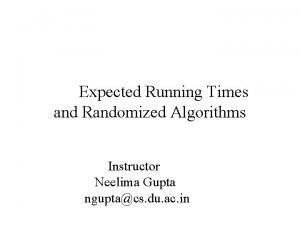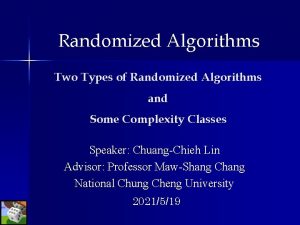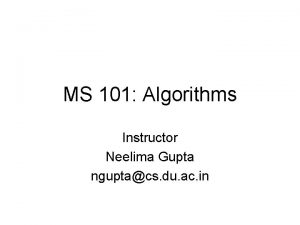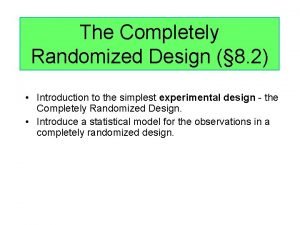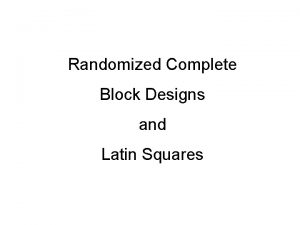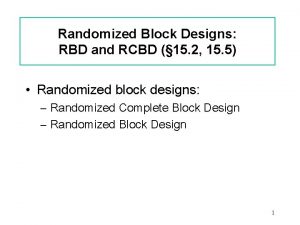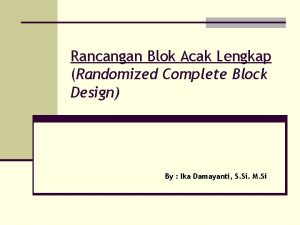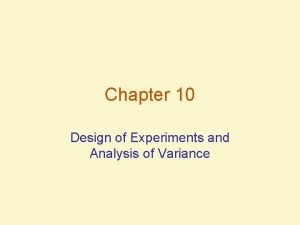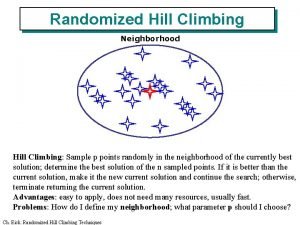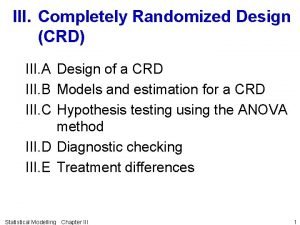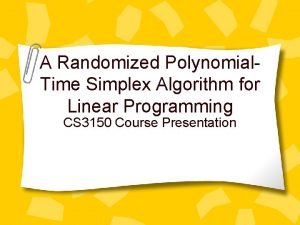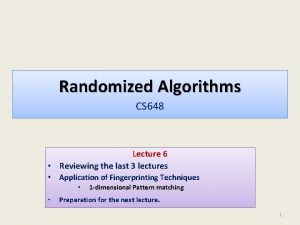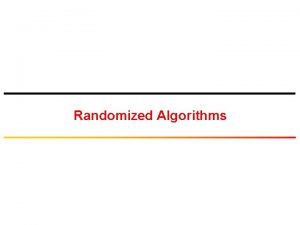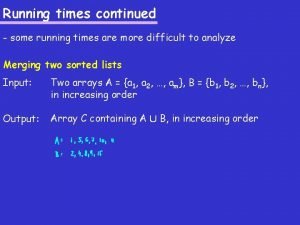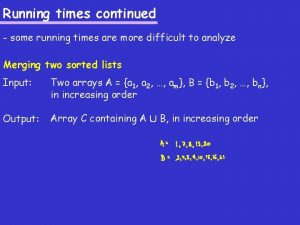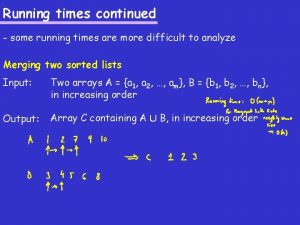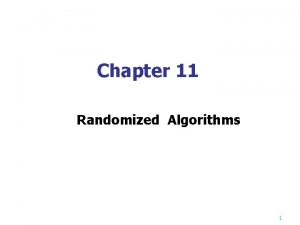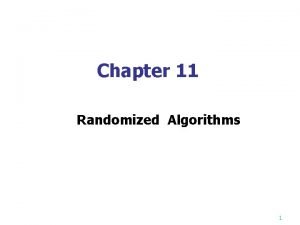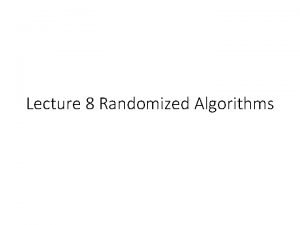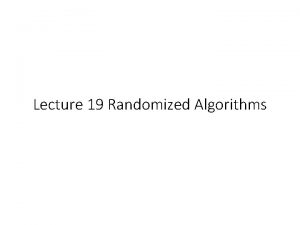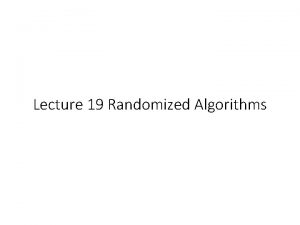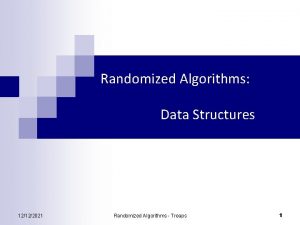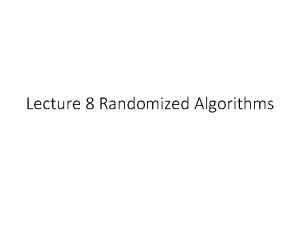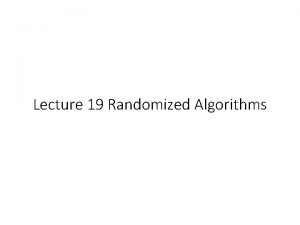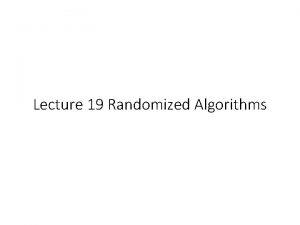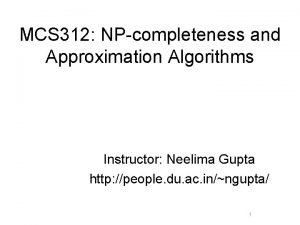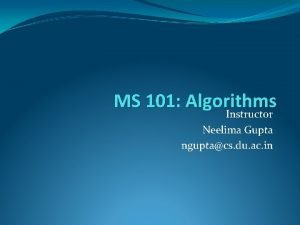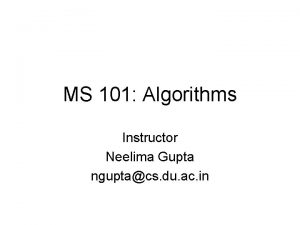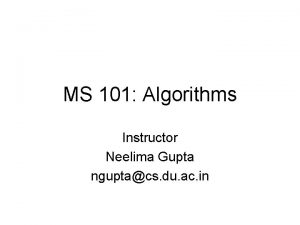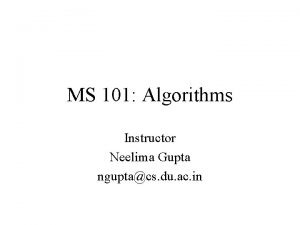Expected Running Times and Randomized Algorithms Instructor Neelima
















































- Slides: 48

Expected Running Times and Randomized Algorithms Instructor Neelima Gupta ngupta@cs. du. ac. in

Expected Running Time of Insertion Sort (at rth position) x 1, x 2, . . , xi-1, xi, . . . . …, xn For I = 2 to n Insert the ith element xi in the partially sorted list x 1, x 2, . . , xi-1.

Expected Running Time of Insertion Sort • Let Xi be the random variable which represents the number of comparisons required to insert ith element of the input array in the sorted sub array of first i-1 elements. • Xi : xi 1, xi 2, . . . . …, xii E(Xi) = Σj xijp(xij ) where E(Xi) is the expected value Xi And, p(xij) is the probability of inserting xi in the jth position 1≤j≤i

Expected Running Time of Insertion Sort (at jth position) x 1, x 2, . . , xi-1, xi, . . . . …, xn How many comparisons it makes to insert ith element in jth position?

• Position i i-1 i-2. . . 2 1 # of Comparisions 1 2 3. . . i-1 Note: Here, both position 2 and 1 have # of Comparisions equal to i-1. Why? Because to insert element at position 2 we have to compare with previously first element. and after that comparison we know which of them come first and which at second.

Thus, E(Xi) = (1/i) { i-1Σk=1 k + (i-1) } where 1/i is the probability to insert at jth position in the i possible positions. For n elements, E(X 1 + X 2 +. . . +Xn) = nΣi=2 E(Xi) = nΣ } i-1Σ (1/i) { i=2 k=1 k + (i-1) = (n-1)(n-4)/4

For n number of elements, expected time taken is, T = nΣi=2 (1/i) { i-1Σk=1 k + (i-1) } where 1/i is the probability to insert at rth position in the i possible positions. E(X 1 + X 2 +. . . +Xn) = nΣi=1 E(Xi) Where, Xi is expected value of inserting Xi element. T = (n-1)(n-4)/4 Therefore average case of insertion sort takes Θ(n 2)

Quick-Sort • Pick the first item from the array--call it the pivot • Partition the items in the array around the pivot so all elements to the left are to the pivot and all elements to the right are greater than the pivot • Use recursion to sort the two partitions partition 1: items pivot partition: items > pivot

Quicksort: Expected number of comparisons • Partition may generate splits (0: n-1, 1: n-2, 2: n-3, … , n-2: 1, n-1: 0) each with probability 1/n • If T(n) is the expected running time,

Randomized Quick-Sort • Pick an element from the array--call it the pivot • Partition the items in the array around the pivot so all elements to the left are to the pivot and all elements to the right are greater than the pivot • Use recursion to sort the two partitions partition 1: items pivot partition: items > pivot

Remarks • Not much different from the Q-sort except that earlier, the algorithm was deterministic and the bounds were probabilistic. • Here the algorithm is also randomized. We pick an element to be a pivot randomly. Notice that there isn’t any difference as to how does the algorithm behave there onwards? • In the earlier case, we can identify the worst case input. Here no input is worst

Randomized Select

Randomized Algorithms • A randomized algorithm performs coin tosses (i. e. , uses random bits) to control its execution • b ← random() if b = 0 do A … else { i. e. b = 1} do B … • Its running time depends on the outcomes of the coin tosses

Assumptions • �� the coins are unbiased, and • �� the coin tosses are independent • The worst-case running time of a randomized algorithm may be large but occurs with very low probability (e. g. , it occurs when all the coin tosses give “heads”)

Monte Carlo Algorithms • Running times are guaranteed but the output may not be completely correct. • Probability of error is low.

Las Vegas Algorithms • Output is guaranteed to be correct. • Bounds on running times hold with high probability. • What type of algorithm is Randomized Qsort?

Why expected running times? • Markov’s inequality P( X > k E(X)) < 1/k i. e. the probability that the algorithm will take more than O(2 E(X)) time is less than 1/2. Or the probability that the algorithm will take more than O(10 E(X)) time is less than 1/10. This is the reason why Qsort does well in practice.

Markov’s Bound P(X<k. M)< 1/k , where k is a constant. Chernouff’s Bound P(X>2μ)< ½ A More Stronger Result P(X>k μ )< 1/nk, where k is a constant.

RANDOMLY BUILT BST Binary search tree can be built randomly. x < > Rank(x)=i Randomly selected key becomes the root. Pivot element=root

HEIGHT OF THE TREE • Xi : the height of the tree rooted at a node with rank=i. • Yi : exponential height of the tree=2^Xi • H=max{H 1, H 2} + 1 where H 1 : ht. of left subtree H 2 : ht. of right subtree H : ht. of the tree rooted at x.

• Y=2^H =2. max{2^H 1, 2^H 2} • Expected value of exponential ht. of the tree with ‘n’ nodes: =E(EH(T(X))) =2/n ∑ max{EH(T(k)), EH(T(n-1 -k))} =O(n^3)=E(H(T(n)))=O(log n)

Skip List : Dictionary as ADT Skip list is a data structure that can be used to maintain dictionary. Given n keys , we insert these n keys in a linked list that has -∞ as first node and ∞ as last node. Initial list S 0 Then we flip coin a coin for each element until only one is left in Si , if a tail occurs, we insert it into next list Si+1 and so on. -∞ 5 9 25 30 35 38 40 ∞

S 3 -∞ ∞ S 2 -∞ ∞ S 1 S 0 -∞ -∞ 30 5 9 25 head 30 Tail ∞ 35 38 40 ∞

Operations that can be performed on skip list Each node has two pointers right and down 1. right Drop down • This operation is performed when after(p)>key. down • In this operation, pointer p moves down to immediate lower level list. p S 1 -∞ S 0 -∞ 9 30 (after drop down) ∞ 30 ∞ 38

2. Scan forward • This operation is performed when after(p)<key. • Here the pointer p moves to the next element in the list. • eg. here key=28 & p is at 9 after(9)<28, so scan forward S 0 -∞ 9 p p 25 p 30 ∞

Searching a key k Keep a ptr p to the first node in the highest list Sh while (after(p)>k) if (Scur==S 0) // Scur is the current skip list then “key k not found”; exit if (after(p)>k) drop down to next skip list If (after(p)<k). scan forward i. e. update p after(p) if (after(p)==k) return after(p);

Searching for a key 25 S 3 p -∞ ∞ S 2 p S 1 -∞ 30 S 0 p -∞ ∞ p 9 30 38 ∞ p -∞ 5 9 p 25 Key found 30 35 38 40 ∞

Searching for a key 28 S 3 p -∞ ∞ S 2 p S 1 -∞ 30 S 0 p -∞ ∞ p 9 30 38 ∞ p -∞ 5 9 p 25 p Key not found 30 35 38 40 ∞

Deletion of a key eg. delete 30 S 3 p -∞ ∞ S 2 p p -∞ 30 S 1 ∞ p S 0 -∞ 9 30 38 ∞ p -∞ 5 9 25 30 35 38 40 ∞

Analysis 1. An element xk is in Si with probability 1/2 i , true ∀ elements. n E(Si ) = ∑ 1/2 i. Xk, i where Xk, i = 1 if xk is in Si, k=1 0, otherwise. = n/2 i E(total size) = E(∑ ISi I) ∞ = ∑ n/2 i ≤ 2 n k=1 2. Expected height of a skip list, h = log n n/2 h =1 ⇛ h ≃ log n

Analysis(contd. ) 3. Drop down O(log n) Since pointer p can drop atmost h times i. e. height of the skip list until S 0 is reached and h = logn. 4. # of elements Scan forward O(log n) Total no. of levels Total Cost to scan at each level O(1) O(log n )

The number of elements scanned at ith level is no more than 2 because The key lies between p and after(p) on the (i+1)th level (that’s why we came down to ith level). And, there is only one element between p and after(p) of (i+1)th level in Si : the element pointed to by after(p) in Si. Thus we scan at most two elements at Si the element pointed to by p (when we came down) and after(p) in Si.

Hashing • Motivation: symbol tables – A compiler uses a symbol table to relate symbols to associated data • Symbols: variable names, procedure names, etc. • Associated data: memory location, call graph, etc. – For a symbol table (also called a dictionary), we care about search, insertion, and deletion – We typically don’t care about sorted order

Hash Tables • More formally: – Given a table T and a record x, with key (= symbol) and satellite data, we need to support: • Insert (T, x) • Delete (T, x) • Search(T, x) – We want these to be fast, but don’t care about sorting the records • The structure we will use is a hash table – Supports all the above in O(1) expected time!

Hash Functions • Next problem: collision U (universe of keys) k 2 0 h(k 1) h(k 4) k 1 k 4 K (actual keys) T k 5 h(k 2) = h(k 5) k 3 h(k 3) m-1

Resolving Collisions • How can we solve the problem of collisions? • One of the solution is : chaining • Other solutions: open addressing

Chaining • Chaining puts elements that hash to the same slot in a linked list: T U (universe of keys) k 4 K k 5 (actual k 7 keys) k 6 k 8 k 1 k 4 —— k 5 k 2 —— —— —— k 1 k 2 —— k 3 —— k 8 —— k 6 —— k 7 ——

Chaining • How do we insert an element? U (universe of keys) k 4 K k 5 (actual k 7 keys) k 6 k 8 k 1 k 4 —— k 5 k 2 —— —— —— k 1 k 2 T —— k 3 —— k 8 —— k 6 —— k 7 ——

Chaining • How do we delete an element? U (universe of keys) k 4 K k 5 (actual k 7 keys) k 6 k 8 k 1 k 4 —— k 5 k 2 —— —— —— k 1 k 2 T —— k 3 —— k 8 —— k 6 —— k 7 ——

Chaining • How do we search for a element with a given key? T U (universe of keys) k 4 K k 5 (actual k 7 keys) k 6 k 8 k 1 k 4 —— k 5 k 2 —— —— —— k 1 k 2 —— k 3 —— k 8 —— k 6 —— k 7 ——

Analysis of Chaining • Assume simple uniform hashing: each key in table is equally likely to be hashed to any slot • Given n keys and m slots in the table: the load factor = n/m = average # keys per slot • What will be the average cost of an unsuccessful search for a key?

Analysis of Chaining • Assume simple uniform hashing: each key in table is equally likely to be hashed to any slot • Given n keys and m slots in the table, the load factor = n/m = average # keys per slot • What will be the average cost of an unsuccessful search for a key? A: O(1+ )

Analysis of Chaining • Assume simple uniform hashing: each key in table is equally likely to be hashed to any slot • Given n keys and m slots in the table, the load factor = n/m = average # keys per slot • What will be the average cost of an unsuccessful search for a key? A: O(1+ ) • What will be the average cost of a successful search?

Analysis of Chaining • Assume simple uniform hashing: each key in table is equally likely to be hashed to any slot • Given n keys and m slots in the table, the load factor = n/m = average # keys per slot • What will be the average cost of an unsuccessful search for a key? A: O(1+ ) • What will be the average cost of a successful search? A: O((1 + )/2) = O(1 + )

Analysis of Chaining Continued • So the cost of searching = O(1 + ) • If the number of keys n is proportional to the number of slots in the table, what is ? • A: = O(1) – In other words, we can make the expected cost of searching constant if we make constant

A Final Word About Randomized Algorithms If we could prove this, P(failure)<1/k (we are sort of happy) P(failure)<1/nk (most of times this is true and we’re happy ) P(failure)<1/2 n (this is difficult but still we want this)

Acknowledgements • Kunal Verma • Nidhi Aggarwal • And other students of MSc(CS) batch 2009.

END
 Expected running time
Expected running time Once upon a time there was a little girl
Once upon a time there was a little girl Running running running
Running running running Probabilistic analysis and randomized algorithms
Probabilistic analysis and randomized algorithms Types of randomized algorithms
Types of randomized algorithms Neelima pandey
Neelima pandey Neelima balakrishnan
Neelima balakrishnan Neelima gupta delhi university
Neelima gupta delhi university 15 times 15 times 20
15 times 15 times 20 Instructor responsibilities and professionalism lesson plan
Instructor responsibilities and professionalism lesson plan Virtual instructor art
Virtual instructor art Randomized polynomial time
Randomized polynomial time Completely randomized design
Completely randomized design Randomized skip list
Randomized skip list Switching replications design
Switching replications design Randomized block design
Randomized block design Advantage of rcbd
Advantage of rcbd Rcbd design layout
Rcbd design layout Factorial randomized block design
Factorial randomized block design Definition of completely randomized design
Definition of completely randomized design Randomized hill climbing
Randomized hill climbing Completely randomized design vs matched pairs
Completely randomized design vs matched pairs Randomized design
Randomized design Randomized hill climbing
Randomized hill climbing Rcbd adalah
Rcbd adalah Crd iii
Crd iii Factorial randomized block design
Factorial randomized block design Randomized polynomial time
Randomized polynomial time Advantage of randomized controlled trial
Advantage of randomized controlled trial Symantha melemed
Symantha melemed Randomized algorithm in daa
Randomized algorithm in daa Two-way anova table
Two-way anova table Participante novato
Participante novato Basic instructor course texas
Basic instructor course texas Basic instructor course texas
Basic instructor course texas Basic instructor course #1014
Basic instructor course #1014 Pepperball instructor course
Pepperball instructor course Not only the students but also their instructor
Not only the students but also their instructor Instructor vs teacher
Instructor vs teacher Ospfv
Ospfv Mptc instructor
Mptc instructor Basic instructor course #1014
Basic instructor course #1014 Basic instructor course texas
Basic instructor course texas Nfpa 1403
Nfpa 1403 Tp 12863
Tp 12863 Instructor operating station
Instructor operating station Catia instructor
Catia instructor Instructor
Instructor Tcole 1014 basic instructor course
Tcole 1014 basic instructor course
